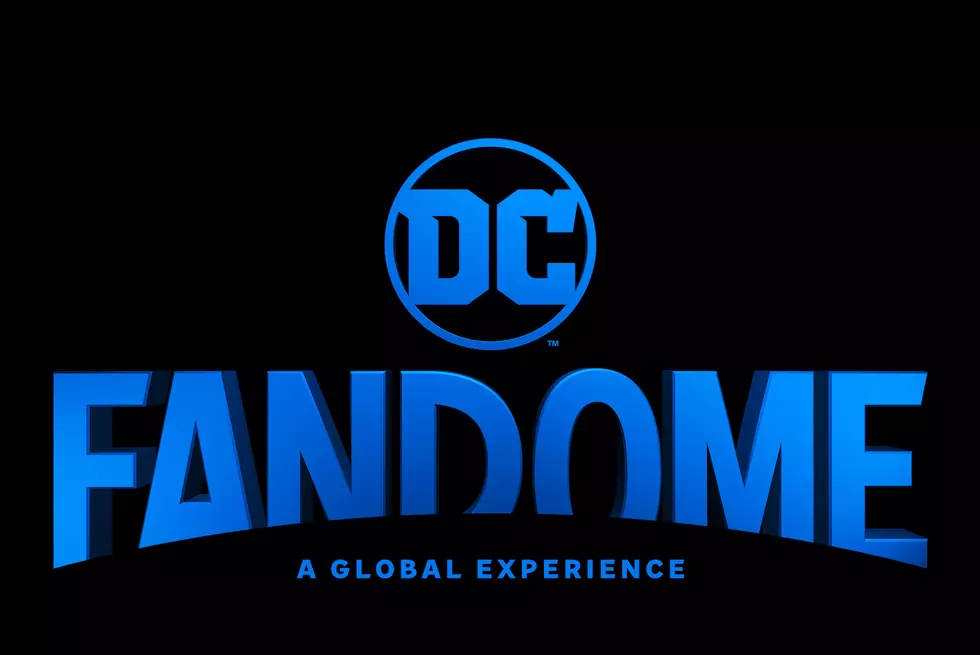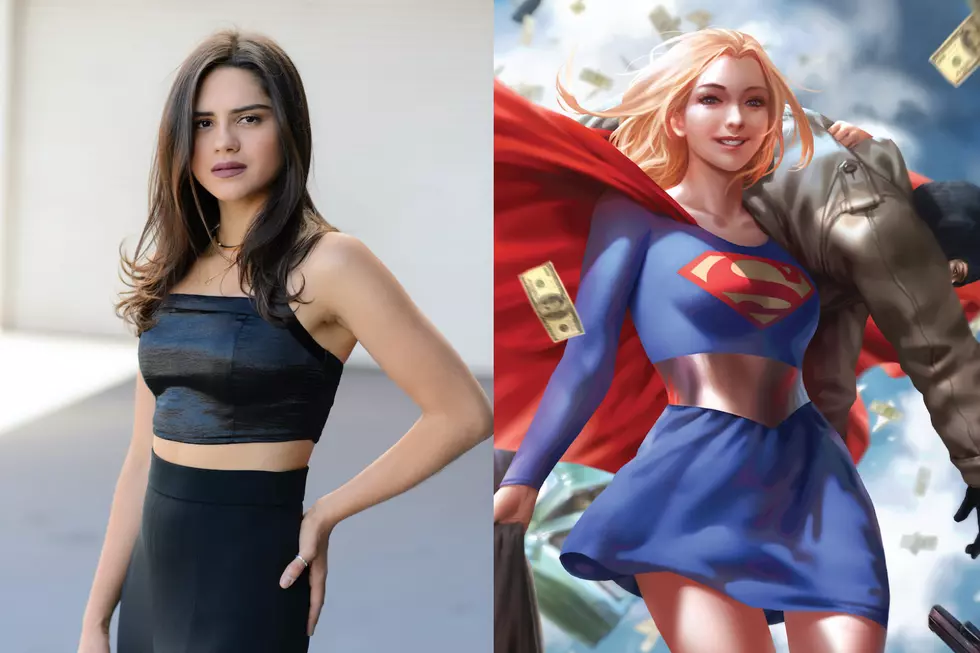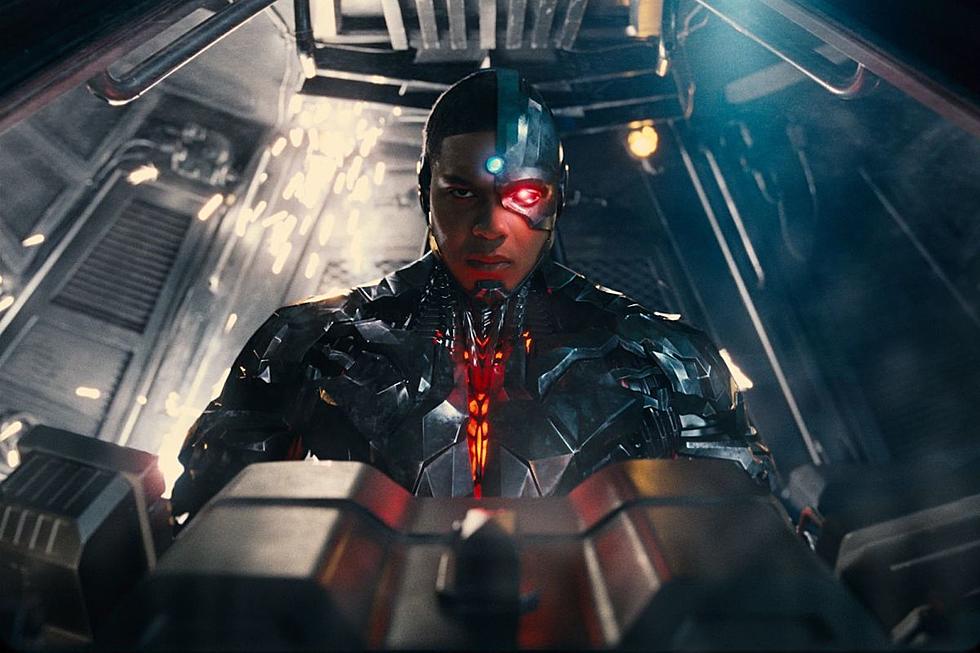
The Stephanie Brown Memorial Awards: ComicsAlliance’s Best Comics of 2012, Part 1

About the Stephanie Brown Memorial Awards
Created by Chuck Dixon and Tom Lyle, Stephanie Brown first appeared in the Batman comics in the early 1990s and operated as the highly dubious "teen issues" character The Spoiler for many years before a brief but truly disastrous yet curiously revered turn as Robin that concluded with her inglorious death. In spite of all this, Stephanie became popular with fans and was resurrected some time later, eventually becoming Batgirl in a series that endeared the character to a newer generation of fans. To the dismay of those readers, that series was cancelled to make way for The New 52's Batgirl starring the original Batgirl, Barbara Gordon, which debuted at the end of last year. Now out of favor with the powers that be, Stephanie Brown has been unceremoniously plucked like a magenta-purple weed from the garden of the DC multiverse and chucked onto the cosmic compost pile that grows eternally in the heart of comic book limbo, where she remained throughout the entirety of 2012.
In this first of a three-part feature, we honor Stephanie's completely fictional memory with this comprehensive recognition of the work we at ComicsAlliance enjoyed most in the year that was.
BEST PUNS-BASED SCIENCE FICTION COMIC
 Multiple Warheads: Alphabet to Infinity
Multiple Warheads: Alphabet to Infinity
by Brandon Graham
Published by Image Comics
Available: Comics shops (print) / ComiXology (digital)
In an era of decompressed stories taking place between larger and larger ad spaces -- thereby causing many monthly comics to take less and less time to actually read -- something like Multiple Warheads is quite refreshing indeed. This is the rare monthly book that feels like a month's worth of book. The scale of the world building here is insane, and the puns per page rate of the first three issues alone has to be some kind of record. Brandon Graham has animated every inch of this world in a way that would make the Flintstones creators blush. Everything in Multiple Warheads has life and a story, even if you just catch a glimpse of it. There is a sense of things carrying on after you've gone that is amazing to behold.
Multiple Warheads: Alphabet to Infinity represents a huge level-up on Graham's work as an artist. There's a sophistication to the line work here that is hugely impressive, which is saying a lot considering the graphic splendor of King City and the first Multiple Warheads. No one creates space on the page with their paneling better than Brandon Graham. No one. The addition of color to Graham's work is a game changer as well. Graham's palette on this book would on its own be enough for it to warrant best of 2012 status. The mainstream scene is one in which gradients and Photoshop painting have kind of taken over, but Graham's flat colors shame them all. These are colors working in time with the line work to enhance the lines, not overtake them.
In a lot of road trip stories the vehicle takes on a life of its own. With Multiple Warheads this is ramped up to 11. The car is actually alive in this book, and is basically the third wheel on this otherwise romantic journey with organ smuggler Sexica and her werewolf boyfriend Nik. Obviously this is the best magical car road trip story since The Love Bug. It's in this strange way that Multiple Warheads finds the right balance between lighthearted humor and real human drama. These characters have an ethos and a reason to do the things that they do, and it gives the book its own kind of languid beauty as the story unfolds around them. A book like this is a challenge to the rest of the industry because so many of its strengths speak to the overall weaknesses in the scene as a whole. There are only a few comics that come out monthly that are worth eating ramen for a week to afford. This is one of them.
BEST COMIC WITH SUPERMAN IN IT
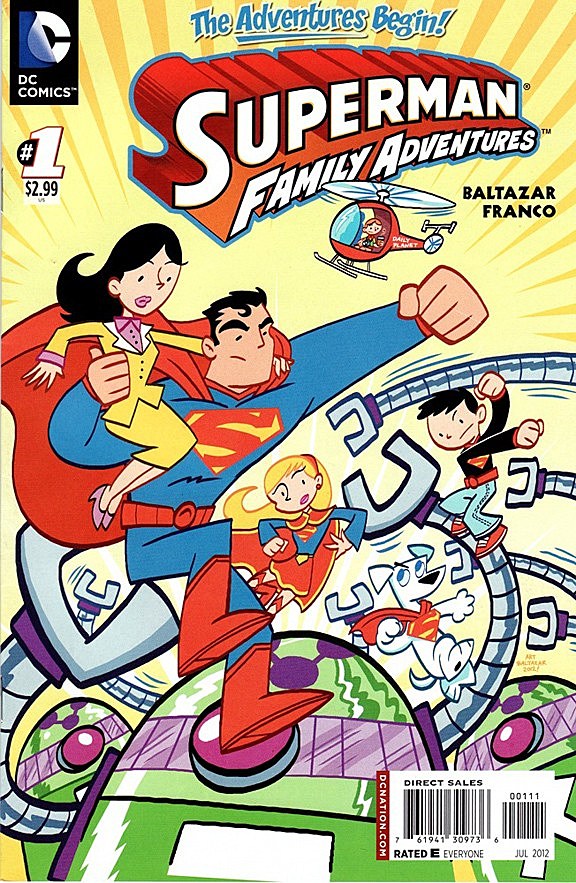 Superman Family Adventures
Superman Family Adventures
Written by Art Baltazar and Franco
Art by Baltazar
Published by DC Comics
Available: Comics shops (print) / DC Entertainment (digital)
Between two ongoing "New 52" monthlies and special projects like Superman: Earth One Vol. 2, Baltazar and Franco's follow-up to their kid-friendly gag comic Tiny Titans had some high profile competition for super-supremacy in 2012, but none that was able to capture some of the Man of Steel's best and most enduring qualities as simply, purely, effectively and regularly as Superman Family Adventures. The comic is a comedy, but one featuring a slightly more mature narrative structure than that of Tiny Titans, with issue-length stories and ongoing subplots and running gags that carry over from issue to issue. And as with Tiny Titans, this series is both a parody of superhero comics as well as a celebration of them.
This version of Superman is basically the Silver Age one, and that of the long-running George Reeves television show of the 1950s, complete with Jimmy Olsen and his signal watch, cantankerous Daily Planet editor Perry White, and the will they/won't they romantic triangle of Superman, Clark Kent and Lois Lane. However, the Superman/Lois relationship is given a bit of a twist with this comic, which is quite endearingly coy about whether Lois knows Clark's big secret or not (most hints point to yes, with Lois playing along to humor Superman). In addition to his co-workers, the "Family" includes Supergirl, all of the Super-Pets (even the pretty obscure Fuzzy, the Kryptonian Mouse), the modern clone version of Superboy and, most recently, Steel and his niece Natasha. The rogues gallery is well represented by Lex Luthor, Metallo, Parasite, Bizarro, Titano and The Toy Man (so far).
Perhaps the more "mature" Superman comic this "all ages" title bears the most resemblance to is Grant Morrison and Frank Quitely's celebrated All-Star Superman. Like All-Star, SFA manages to pluck the best versions of multiple aspects of the Superman mythos -- from all decades and all media -- and synthesize them into something that feels natural and organic rather than a Frankenstein's monster-like pastiche. It's a remix, albeit one with a sweeter melody and a greater, wider appeal -- more bubblegum pop than angsty rock and roll.
For some readers, the most obvious sign of Superman Family Adventures' superiority to the 2012's other super comics is this: Baltazar is so far the only artist who's been able to make the "New 52" brief-less, turtle-neck version of Superman's costume look good. By smoothing out all the unnecessary lines and giving it a flat, animated-style texture, Baltazar's "new (52) look Superman" looks like he's wearing a refined version of his old costume and not a silly suit of armor. It's just one more reason why this particular series isn't just super, it's the most super.
BEST COMICS EXPOSÉ OF LITTER GANGS
 Cody
Cody
by Michael DeForge
Self-published on the Web (link)
With somebody as prolific as Canadian indie cartoonist Michael DeForge, it's tough to pick a comic to point to as a good indicator of what he does best. This year has seen him publish the wonderfully bizarre Incinerator, another issue in his Lose series, weekly updates to his Ant Comic, various poster and cover illustrations, and a metric ton (because he's Canadian, get it?) of short stories to indie anthologies as well as his own website. Oh, and he also works designing props, characters and effects for the Adventure Time animated series when he's not doing all that other stuff. The guy has got hustle.
My favorite strip of his this year, however, was an improvised minicomic titled Cody. It's not tagged on his site, but a search will bring up the pages for you to read. And you're gonna want to read it because it is great. Cody starts off with the titular character running into a DeForge stand-in named "Michael," a former co-worker who is "an animator or illustrator (or something)." The two strike up a conversation that ends with Michael handing Cody a Chick-Tract-type pamphlet titled "CHOOSE LITTER," a recruitment tool for litter enthusiasts. It sets Cody down a path toward secret meetings in grocery store aisles, hand signals and tree nut allergies, all rendered in DeForge's grotesque yet cartoony style.
Reading Cody I was reminded of Thomas Pynchon's The Crying of Lot 49, a meandering story of a woman who uncovers an ancient secret postal system that operates in opposition to the federally-funded system. You read that right. There's also a David Foster Wallace essay where Wallace pinpoints what makes a David Lynch "Lynchian" -- "a particular kind of irony where the very macabre and the very mundane combine in such a way as to reveal the former's perpetual containment within the latter." Cody is, I would submit, a very "Lynchian" work in that it exposes a secret society that exists quietly all around you, whose existence can only be measured by looking at the bottoms of fences or in rain gutters or skidding across the road when the wind picks up.
MOST TRIUMPHANT RETURN
 Real and Vagabond
Real and Vagabond
By Takehiko Inoue
Published by Viz Media
Available: Viz store / Comics shops
You might not realize it, but Takehiko Inoue is one of the greatest comics artists going. He's got killer storytelling, a fantastic art style, a couple other nice art styles on top of that one, a couple hit mangas about basketball, and Vagabond, a fictionalized account of the life of Miyamoto Musashi.
Inoue put his career on hiatus in August, 2010. Those of us who were in the know immediately stripped off our clothes, draped ourselves in our mourning regalia, and set about wailing and lamenting our loss. The hiatus came because he'd gotten sick, but Inoue doubled down on that break later that year. He wasn't happy with the quality of work he was producing, so until he got back into fighting trim, he was placing his two ongoing series, Vagabond and Real, on hiatus.
Fair enough. I can't really blame someone for being dissatisfied with their work. At the same time, though, allow me to say that Real, Inoue's wheelchair basketball epic, and Vagabond never slipped an inch. And that's why we Inoue fans were so bummed by his departure and prayed it would be temporary. He didn't leave us hanging, exactly, but you don't really want great things in your life to leave, do you?
He's back now. He's been back for a while, but Viz, his US publisher, has only just begun shipping his latest collected editions. Real volume 11 is on store shelves now, and Vagabond volume 34 ships early next year. Vagabond Vizbig volume 11 -- a three-in-one collection in a larger deluxe format -- just recently came out, too. We're back in the zone, ladies and lads, and finally skies are blue again. Everyone calm down and exhale. The king is back, and his comics are as great as ever.
BEST COMIC BOOK FEATURING A BOOTLEG BATMAN
 The Furry Trap
The Furry Trap
By Josh Simmons
Published by Fantagraphics
Available: Fantagraphics store, comics shops
"Mark of the Bat" appears about a quarter of the way through The Furry Trap by Josh Simmons, and, like Simmons's other comics, it's an unsettling slice of graphic narrative. The faux-Batman comic, which details the Bat's horrifically misanthropic ways, might be a reason to check out the contents of this hardcover collection of Simmons stories, but the entire volume is full of troubling tales worth your attention.
You might flinch, as these are "Horror Stories" according to the back cover, but they don't follow the traditional genre rules.
Instead, Simmons unleashes one short comic story after another, most of them filled with perversions and all of them designed to exhibit different visual approaches. Every chapter in this book shows Simmons trying out another style -- it's a variety of color schemes and page layouts and narrative modes. Perhaps it might be appreciated as a good sampling of what comics can look like and how form can contribute to function in storytelling. But this is no fancy Chris Ware comic. This is Josh Simmons and deep discussions of art and storytelling seem pretentious when faced with his rape-minded savage elves, his gargantuan naked centaurs with flaming swords and laser eyes, and his hot-dog-eating, chain-smoking demonic babies.
The Furry Trap is the kind of book where any attempts at plot summary seems to totally miss
the point. These disturbing stories depend on the reader's experience of first encountering them. Simmons' artistry plays an important part - the visuals, no matter the mode, are consistently striking in their directness -– but it's the tone that creates the sense of weirdness and panic. Simmons's world is clearly drawn, but impossible to define by typical measures. The unexpected happens, consistently, and that's about the only thing you can be sure of.
In horror movies, there's sometimes a scene where a character, usually a child, turns toward the camera with a fearful look and the combination of vulnerability and terror is so potent that even the schlocky thrills of the rest of the scene can't peel your mind away from that one image. Josh Simmons's comics feel like that all the time. Vulnerability and terror. Housed in a pretty and grotesque and sexualized and shadowy and surreal package.
- Tim Callahan
MOST GORGEOUS TITLE PAGES
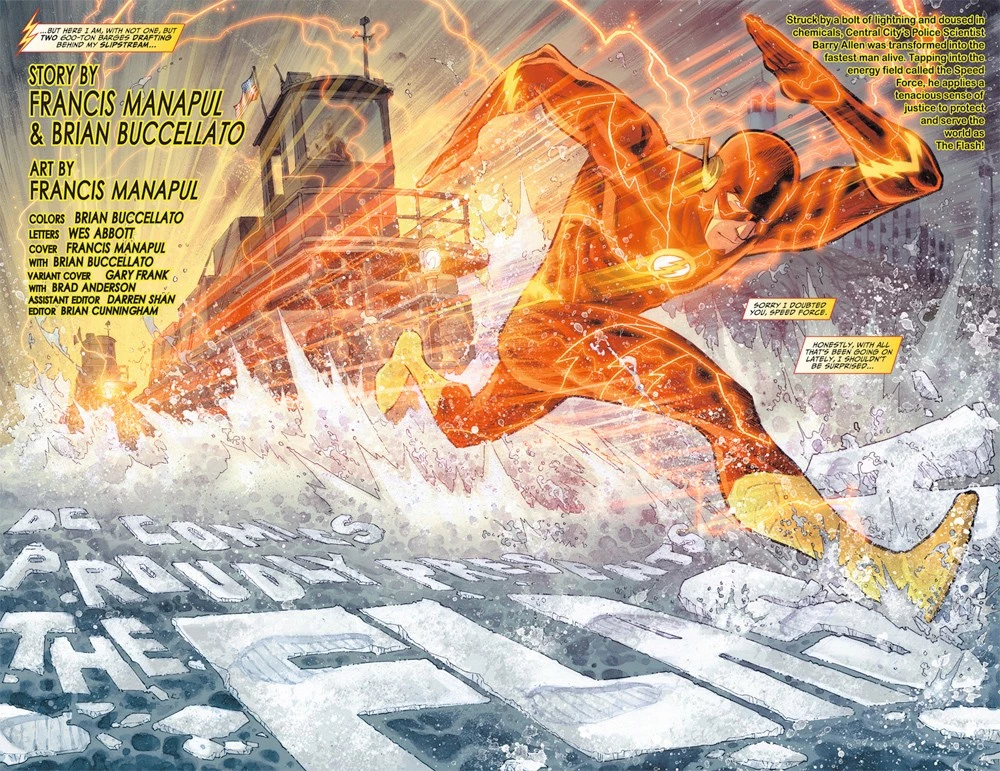 The Flash
The Flash
Story and art by Francis Manapul and Brian Buccallato
Lettering by Wes Abbot
Published by DC Comics
Available: Comics shops (print) / DC Entertainment (digital)
The art of the great title page is as lost as Milo & Otis. These days it's mostly just boring text placed somewhere in a gap somewhere within the artwork, in no way pleasing visually or thematically. A few good books go to the effort of having nicely designed separate pages just for titles and credits, and some books spread things out in a way that's graphically interesting and conveys a sense of wholeness, but most of these borrow method and pacing from movie titles. Very, very few books go to the effort to incorporate the title into the artwork itself even though it's trick that only comics can do, and despite the fact that tons of comics used to. The technique has fallen to the wayside but it's still practiced by rare books like Mud Man and Batwoman. But as great as Paul Grist and J.H. Williams are at this particular craft, they're absolutely getting lapped by The Flash.
Drawn by Francis Manapul with color by Brian Buccallato and complimentary letters by Wes Abbot, The Flash is demonstrating creative, kinetic, beautiful title pages that leap at you from the artwork. Every month, Manapul's exceptional sense of design, pacing, and intense visual imagination result in the some of the most satisfying title pages in mainstream funny books since the days of Will Eisner and Jim Steranko. It's the highlight of every issue of The Flash. Not the way Manapul and Buccallato have re-captured and modernized the spirit of the character, not the way they're re-spun the Rogues Gallery or the Speed Force into great new stories that pay homage to the Flash's history while moving everything forward. No, baby, it's that Day-in-the Life-like build-up of energy and discord that blazes by in a whoosh of red and ecstatically resolves into living words. "DC Comics Proudly Presents The Flash." Yeah, if I had title pages that looked like that, I'd be a bit more than "proud." They should change it to "Holy S*** Did You See What Just Happened: The Flash."
BEST BATS**T CRAZY SPACE OPERA THAT'S ALSO A QUITE TOUCHING FAMILY DRAMA
 Saga
Saga
Written by Brian K. Vaughan
Artwork by Fiona Staples
Published by Image Comics
Available: Comics shops (print), ComiXology (digital)
You don't title a comic book Saga unless you have some pretty big plans for it. And in its eight issues released in 2012, Vaughan and Staples have certainly woven a wide and complex tapestry with their story of what seems to be a never-ending and planet-spanning war between two societies, intergalactic bounty hunters, TV-headed nymphomaniacal nobility, and giant spiders with boobs. In fact, I'll be honest: There are so many moving parts that I occasionally had trouble keeping tabs on the various Saga subplots month to month. I found myself going back and rereading more or less the entire series each month to remember what The Will was all about or remind myself which TV-headed royal was which. Fortunately, Saga isn't just a series that calls for multiple readings because of various threads, it also warrants them. And what most justifies paging back through each issue isn't the bigness of its universe; it's the intimacy of its core story.
The boundary-crossing romance that anchors Saga seems shockingly simple for such an ambitious comic. A woman with bat wings and a guy with ram horns find themselves locked in a forbidden love, Romeo and Juliet-style. But Romeo and Juliet never conceived a baby that is clearly a Very Special Child. The book's first arc establishes that Alana and Marko are in love and on the run from both their home societies; the second is about Alana meeting Marko's parents.
Like all good science fiction or epic fantasy, Saga has grand aspirations but introduces the audience to the world through a handle they can hold onto: human (or at least human-like) characters experiencing family drama. After all, Star Wars was ultimately about a brother and sister encountering their long-lost dad. Even with all the big ideas of tree spaceships and ghost babysitters, Saga is ultimately about how much two parents love their kid and how much they want to protect it. As a gateway to a universe of inspired otherworldliness, it's securely grounded.
BEST COMIC THAT WON ALL THOSE AWARDS
 Jim Henson's Tale of Sand
Jim Henson's Tale of Sand
Screenplay by Jim Henson and Jerry Juhl
Adapted by Ramón K. Pérez
Published by Archaia
Available: Comics shops
If people didn't expect exactly great things from the lost, unproduced screenplay for an experimental, abstract, acid trip of a feature film called Tale of Sand, written by the great Muppet Show creators Jim Henson and Jerry Juhl, they certainly expected something interesting. Little did anyone suspect that what on paper seemed very pretty but perhaps a little, well, artsy fartsy, would launch into the mainstream one of comics' most captivating new artists and become what's very arguably the most gorgeously illustrated graphic novel of the year when it was first released in the very final days of 2011 (which precluded its recognition on basically every list such as this last year).
Ramón K. Pérez used the surreal setting imagined by the late Henson and Juhl -- who wrote Tale of Sand at the end of a period of very innovative and groundbreaking work the 1960s -- to immerse readers in a meticulously drafted universe of haunting old west mesas, small town sock-hops, paranoid nightmares, bikini girls of doom, atomic horror, and jazz-fueled odysseys across dreamlike dance floors. And while it's easy enough to simply throw all those things at the page and call it all it a day's abstract work, Pérez demonstrated truly uncommon skill with comics storytelling, designing pages that lead the reader's eye on a journey almost as exciting as that of Tale of Sand's intrepid hero, Mac, as he runs for his life to the finish line.
Pérez followed Tale of Sand with under-promoted but similarly excellent work on Marvel's sci-fi adventure miniseries John Carter: Gods of Mars, and is now the permanent co-artist of that publisher's very popular superhero series, Wolverine and the X-Men. I'm glad bigger and bigger audiences will be seeing Pérez's fine work as his career continues to ascend, and as an art fan I'm eager to see him try to leap the incredibly high bar he set for himself with Tale of Sand, which deservingly won the 2012 Eisner awards for Best Graphic Album-New, Best Publication Design and Best Penciller/Inker.
BEST VARIANT COVER ARTIST
 The Internet
The Internet
For Adventure Time, Marceline and the Scream Queens and Bravest Warriors
Published by Boom! Studios
Available: Comics shops (print) / ComiXology (digital)
Boom! Studios is known for its pretty robust alternate/variant cover strategy, but the publisher Kaboom!-ed to new heights in 2012 across its Adventure Time, Marceline and The Scream Queens and Bravest Warriors books. We're not complaining -- far from it -- because rather than tap the same half-dozen or so superhero cover artists you see almost everywhere else, Boom! followed Frederator's lead and recruited tons of talent from the wider world of webcomics, animation and social media to deliver four-to-six awesome pieces of art to gawk at every single month. They've done so many, in fact, that an Adventure Time Cover Showcase collecting scads of art was released to answer fan and art lover demand.
Joining interior creators known for their own indie projects such as Ryan North (Dinosaur Comics), Meredith Gran (Octopus Pie) and Joey Comeau (A Softer World) for covers have been everyone from AT creator Pen Ward to James Kochalka to Ming Doyle. In 2012 alone, the following artists illustrated a cover for at least one of these comics, with many working on several:
Shelli Paroline & Braden Lamb, Chris Houghton, Jeffery Brown, Chris Samnee, Sanford Green, Pendleton Ward, Jon Bennett, Emily Carroll, Becky Dreistadt & Frank Gibson, Elena Barbarick, Michael DeForge, Stephanie Buscema, Kassandra Heller, Scott C., Bettie Ward, Paul Pope, James Lloyd, Dan Hipp, Steve Wolfhard, Mike Krahulik, Eleanor Davis, James Kochalka, Jason Ho, Graham Annable, Franco Aureliani, Drew Weing, Colleen Coover, Phil McAndrew, Shannon Wheeler, Joe Quinones, Jon Vermilyea, Tyson Hesse, Victoria Maderna, Nick Edwards, Kevin Wada, Logan Faerber, JJ Harrison, Rich Kolowski, JAB, Lisa Moore, Brianne Drouhard, Camilla D'Errico, Rich Tommaso, Lucy Knisley, Steve Wands, Chynna Clugston, Andy Hirsch, Kate Leth, James Hindle, Zack Sterling, Tally Nourigat, Faith Erin Hicks, Yuko Ota, Vera Brosgol, Erica Henderson, Jen Wang, Malachi Ward, Jon Boam, Aaron Renier, John Martz, Jim Rugg and Maris Wicks.
This huge list of talent reads like our art-stuffed Tumblr feeds, and that's just fine with us. Keep it coming in 2013, Boom!.
BEST ARCHIVAL COLLECTION OF AMAZING BUT OCCASIONALLY RACIST MATERIAL FROM THE 1930S
 Walt Disney's Mickey Mouse: House of the Seven Haunts!
Walt Disney's Mickey Mouse: House of the Seven Haunts!
By Floyd Gottfredson
Published by Fantagraphics
Availability: Fantagraphics store / Comics shops
Over the past year, Fantagraphics' reprints of Floyd Gottfredson's Mickey Mouse strips have been some of my favorite things to read. They're one of the few things that I get excited about to the point of giddiness, and House of the Seven Haunts! was the best volume yet. Virtually everything about Gottfredson's craft in these strips is mind-blowing, especially when you consider that they were written and drawn in 1936. The comedy, the adventure, the pacing that saw these four daily panels building into sprawling, months-long epics that were built around exotic adventures and thrilling set pieces.
It's the variety that really puts this one over the top. The title story finds Mickey, Goofy and Donald team up as ghostbusters to exorcise a house that's been taken over by alarmingly rude ghosts and then takes slapstick Scoobydoovian twist, but there are also stories of Mickey going undercover for the G-Men and joining up with the Foreign Legion, a pulpy sci-fi serial about a scientist who discovers a terrifying atomic power, and a twist on the Prince and the Pauper where Mickey's brought in to fix his royal double's tax structure before the peasantry starts revolting. It's one wild adventure after another, and they're all done with an incredible skill that still holds up almost 80 years later.
But there's a catch.
Like a lot of comics from the time, Gottfredson's strips occasionally rely on offensive racial caricatures for gags, and they're always bad enough to wrench you right out of the story. Mixed up in those classic tales mentioned above is a story called "In Search of Jungle Treasure," and as you might imagine, that thing is about as rough as they come, full of the kind of uncomfortable stuff that'll lead you to just start turning pages until it's all over. But to their credit, Fantagraphics and editor David Gerstein -- who discussed the problematic stories in an interview here at CA -- never shy away from addressing these segments in the lengthy text pieces that supplement each comic, with explanations of why they opted not to edit the original strips. The end result is a book that owns up to the truly awful mistakes of the past, and ends up being one of those rare comics that shows you everything comics can do, and a bunch of stuff they definitely shouldn't.
CRUELEST CANCELATION
 Takama-ga-hara
Takama-ga-hara
By Jyuuzou Kawai
Published by Viz Media
Available: Weekly Shonen Jump Alpha (digital)
Sometimes you read a comic and it just clicks. It doesn't have to be a great work or some heartbreaking work of staggering genius. Sometimes it's just a simple idea that is executed well. It's the kind of comic that you want your friends to check out, just because it's such a nice read. And then, because no one gets to have anything nice ever, that comic gets cancelled.
May I introduce you to Jyuuzou Kawai's Takama-ga-hara? A series that lasted a mere 17 chapters before being canceled, but not before it grabbed my attention. It started out slow and sort of weird. Yamato Yamada is from a family of fitness nuts, wrestlers, and brawlers. Rather than being interested in getting swole, however, Yamato just wants to draw manga for a living. So of course he discovers that he has tremendous special powers, gets sucked into another dimension, and basically turns into the most-shonen of shonen comics heroes.
Takama-ga-hara is a self-aware work. That's obvious from the point that someone reads a manga that's so terrible that they almost die. So as Kawai stacks shonen trope on shonen trope, the question isn't, "What's the point?" It's, "How is this going to be upended?"
The comic takes everything that makes the shonen category such goofy fun and turbocharges it. If you're into stories about boys walking the path of undeniable justice and undying friendship, you need to check out Takama-ga-hara. If you like shonen comics like Akira Toriyama's Dragon Ball or Eiichiro Oda's One Piece, but wish that they had more fun with the tropes of the genre, then you seriously need to check out Takama-ga-hara.
BEST POSTHUMOUS HARVEY PEKAR COMIC
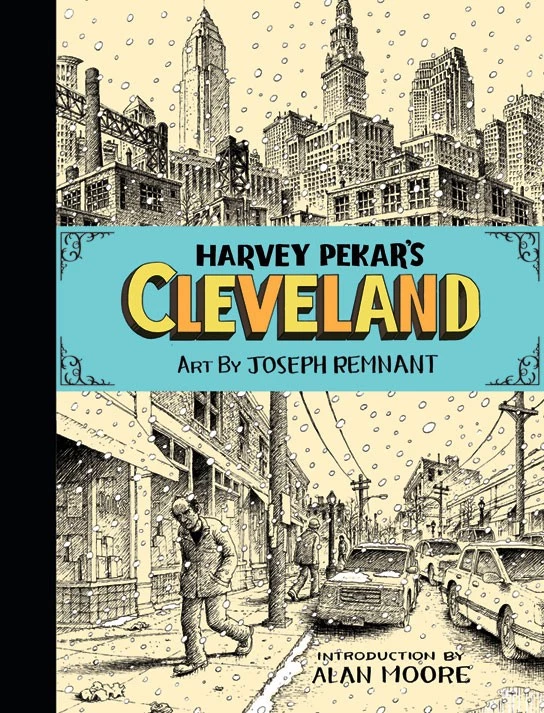 Cleveland
Cleveland
Written by Harvey Pekar
Artwork by Joseph Remnant
Published by Top Shelf Productions
Available: Top Shelf store (print and digital) / Comics shops (print)
Harvey Pekar may have passed away in 2010, but due to how prolific a writer he was and how long it can take an artist to draw an entire graphic novel, two books he wrote were only published for the first time this year. Both were fine works from a fine writer working with talented collaborators, but one was more dominant than the other. Pekar's Not The Israel My Parents Promised Me, drawn by Megillat Esther artist JT Waldman, is a memoir of Perkar's ever evolving feelings on the politics of Israel, from those of a young Jewish boy in a Jewish home in a Jewish part of Cleveland to those of an older man who watched a half-century and change of Israel's history from afar.
For a framing device, this book depicted Waldman and Pekar talking about the book they were making together, hanging out in some of Pekar's favorite places in Cleveland. You see, I can't even mention Pekar's book about Israel without mentioning Cleveland repeatedly, which just goes to show how important that city was to the legendary writer, who had over the years become something of a spokesman and good will ambassador for his hometown (or maybe just ambassador, since not all of the will was good).
That one of his last published books was entitled Cleveland and was about the city itself as much as it was about Pekar was beyond fitting. Working with artist Joseph Remnant, whose particular style was reminiscent of the work of several of Pekar's favorite and best-known collaborators over the decades, the book intertwined the city's history with Pekar's endlessly fascinating biography, blending the two until the story of one became the story of the other. As such, Cleveland embodied what was so special about Pekar as a writer and as a comic book character. He was the ultimate everyman hero, heroic in his insistence that the everyman character is a hero, the seemingly insignificant aspects of such a character's life as worth as chronicling in comics form as those of supermen or cowboys or romances or illustrated classics.
Cleveland is to Harvey Pekar as Gotham City is to Batman or Metropolis is to Superman, but Cleveland's story is a more dynamic, more vital, more relevant one, for the same ways Pekar is a more present hero: Cleveland is a real place, just like Harvey Pekar was a real person, and one whose intensely personal work -- hugely informed by the city he called home -- will captivate us always.
BEST ABSOLUTELY CRAZY COSMIC FIGHT COMIC TO HEAVILY REFERENCE THE TRANSFORMERS: THE MOVIE (1986)
 Sharknife: Double Z
Sharknife: Double Z
By Corey Lewis
Published by Oni Press
Available: Oni store (print) / Comics shops (print) / ComiXology (digital)
The story of busboy Ceasar Hallelujah -- who transforms into the cosmic warrior Sharknife by eating a magical fortune cookie -- and his mission to protect the restaurant Guandong Factory (famous for dumplings) from all enemies -- including Ombra Revenga, wielder of the Orcasword -- Sharknife got its second volume this year, and kind of without much fanfare, curiously. You'd expect a bigger reaction for a work that is so bursting at the seams with raw comics energy. A significant level-up on the first volume, Sharknife: Double Z can barely contain itself with layouts and compositions that make the video game eye candy of something as kinetic as Marvel vs. Capcom look stately and reserved. Lines full of electricity crackling across the page characterize the majority of this book, which is very difficult not to get caught up in. It is almost a breathless read in terms of the sheer velocity of its architecture.
While Sharknife: Double Z has style for miles and miles, the story remains coherent and enjoyable. It's a -- and it's strange to say this -- down-to-earth interpretation of the Shonen Dragonball Z/Naruto style of adventure story mixed with the best bits of Capcom 2D fighting games. It is both a familiar brew and a strange one at the same time. Reading Double Z, you can see things you remember or enjoyed from other places, yet the context is alien and the style is extradimensional. Taking its cue from Lewis' hyperactive artwork, the narrative bolts around chronologically with its own strange energy, building a deeper Sharknife mythos that is was already pretty impressive.
This book was live wire comics for 2012. There was no experience reading a comic this year that was anything like Sharknife: Double Z. Let's start a cult following.
MOST PRESIDENTIAL COMIC
 Barack Hussein Obama
Barack Hussein Obama
By Steven Weissman
Published by Fantagraphics
Available: Fantagraphics store / Comics shops
It might be easier to describe this comic by talking about what it isn't. Steven Weissman's Barack Hussein Obama is not a Bluewater-style biography of the current president of the United States. It's not any sort of political treatise. In fact, it's not anything close to an accurate portrayal of political life in the 21st century in any way, shape or form.
So, if it's not any of those things, what is it, then? Well, that's when things get complicated. Barack Hussein Obama is a collection of goofy, meandering, almost improvisational one-page strips that show a Bizarro President Obama as a regular guy with irregular, often existential problems. There's something vaguely Peanuts-esque at work here, with a cast of recognizable characters (Joe Biden's here; a monstrous, veiny Secretary Clinton is here; and the breakout characters of 2012, the fictional versions of the Obama daughters, Sasha and Malia, are here), all with their own quirks and personalities, all delivering punchlines while the specter of death and soul-crushing doubt hangs over their heads. It's funny, but like any good comedy, it's tied up in uncomfortable and relatable truths.
Presented with rough, highly stylized pen strokes, white out, and zip-a-tone on cream-colored Moleskine notebook pages, Barack Hussein Obama starts off gentle, but as it progresses, starts to lean into its punches, with the titular character beginning to strain under that weight. At one point, Obama turns into a giant parakeet and flies to a deserted island with his daughters before then turning into an egg that simply sits there, waiting. It's funny but also unsettling, which is sort of Barack Hussein Obama in a nutshell. It's surreal, nonsensical, and a little depressing -- so, huh, maybe it's an accurate portrayal of political life in the 21st century after all.
BEST STRAIGHT UP SLAP IN THE GOD DAMN FACE
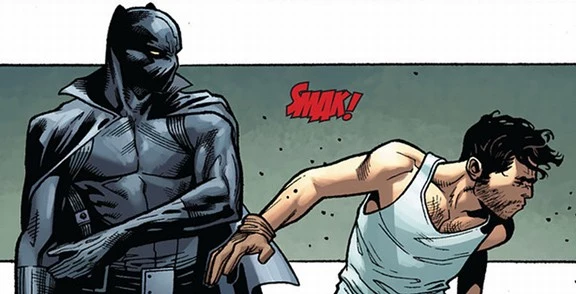 Avengers Vs. X-Men #7
Avengers Vs. X-Men #7
Story by Jason Aaron, Brian Michael Bendis, Ed Brubaker, Jonathan Hickman and Matt Fraction
Script by Matt Fraction
Artwork by Olivier Coipel, Mark Morales and Laura Martin
Published by Marvel Comics
Available: Comics shops (print) / ComiXology (digital)
Marvel editor-in-chief Axel Alonso described the Avengers Vs X-Men series as the publisher's equivalent to a summer blockbuster. So think of it like a Michael Bay movie, or a Paul W.S. Anderson movie, or Battleship. You'll find it quite an easy comparison to draw.
Regular readers will know that ComicsAlliance paid quite close attention to AvX this summer. In our considered and scholarly opinion the event found Marvel at a crossroads. Would it keep pushing for the pomposity of its Civil War world, investing its superheroes with po-faced seriousness by squeezing them into the uncomfortable shoes of sophomoric political posturing? Or would it celebrate the fantastical grandeur and visual vibrancy of the genre with stories that explored the big, bold, new ideas that make superheroes great?
AvX felt like an attempt to wrestle with that choice. On the one hand it gave us a rehash of Civil War with the tub-thumping, bloviating roles of Cap and Iron Man now played by Cyclops and Cap; on the other it gave us the gloriously flashy theater of cosmically-enhanced mutants reshaping the world in their image, in their underpants.
In the seventh issue of AvX, Iron Man plotted to take down the Phoenix Force by sacrificing his own life. And Black Panther just straight up slapped the martyr complex out of him, and told him to apply a little magical thinking to his superscience. Given the choice between maudlin self-indulgence that I can find anywhere, and majestic wizz-boom crazy that I only seem to consistently find in superhero comics, I know which one I'd like to see more of.
So I encourage you to applaud the act of the bold slapping the boring out of superheroes. Because Black Panther hitting Iron Man is the sound of one hand clapping.
Come back tomorrow for the second part of ComicsAlliance's celebration of the best comics of 2012, when we will honor yet another hero who lost their life in the line of totally made-up duty.
More From ComicsAlliance




